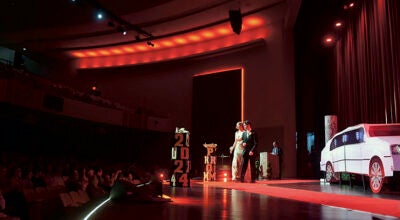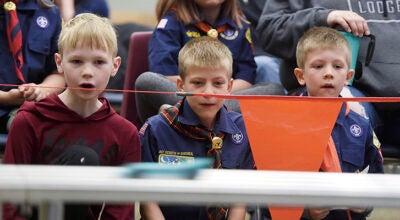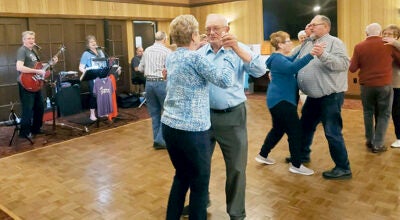Brownsdale’s work of art
Published 6:51 am Wednesday, April 28, 2010
BROWNSDALE — They quit the business twice, but they kept coming back. It’s in their blood.
Larry and Karen Sheely own Midwest Garden Art, 23200 State Highway 56 between Interstate 90 and Brownsdale, where they make and sell cement statues.
For the Sheelys, their store is far more than just retail, it’s a way of life.
Larry makes all his own molds and pours the concrete statues himself. Larry described pouring concrete as a lost art that is only done by about five other people in Minnesota.
Larry and Karen combine their skills to make and sell a variety of cement statues. Many of the figures include things like angels, dogs, firemen, deer, eagles, birdbaths, flower planters and many more. Eagles and deer are some of the biggest sellers, Karen said.
Since the Sheelys are retired and operate the business out of their home in a garage converted to a shop, they don’t have set daily hours. According to their business cards, they’re open by hit, miss or appointment.
While Karen admits Larry first sparked an interest in the art before she did, she said it becomes a passion that’s hard to shake.
“I always tell everybody it gets in your blood,” she said. “You just can’t quit. It’s so challenging making the new molds and seeing them come out and painting them the first time. It got in my blood.”
The two sold their molds twice to leave the business, selling about 325 molds each time. As Karen said, it was in their blood, and they were back in business within a year.
However, Larry doesn’t regret selling his molds. They made good money, and Larry said he kept many of his master molds.
“Every time I remake them, I make them better than I did the other time,” Larry said. “I can take my master and say, gosh that should have hair lines. The face should be different, and I make it different.”
Though they moved to northern Minnesota for a number of years, Larry and Karen were first introduced to the concrete statues in Brownsdale. Shortly after they bought their first home, they bought a stone fountain at a shop in Brownsdale. Larry bought 14 molds through an advertisement in a newspaper, and he started in their garage.
From 1974 to 1980, they owned a shop in Maple Plain. In 1986 they moved to Brainerd and opened a shop called the Loon’s Nest, which they sold in 1996 along with all their molds. They then moved back to Austin to be near their grandchildren when they retired.
Larry and Karen built and sold the statues full time for about 11 years in Brainerd, and they sold their statues wholesale to other businesses. However, Larry said it was difficult to maintain the quality. Because of the lengthy, complicated process to make each statue, Karen said it’s difficult to make a living selling statues.
Larry said it’s especially difficult because you have to make a living between Mother’s Day and Labor Day.
Soon after moving back to the Austin area, Larry began building up his mold inventory again and then he opened Midwest Garden Art. About a year ago, Larry retired, and they’ve been making the lawn ornaments full time.
Creation
Each of his molds starts out with a master, sometimes made out of clay or other materials, that he covers with latex rubber. One mold was made from a damaged clay statue that Larry covered with clay to re-shape and add details like hair lines and other markings. Larry made one mold using an old lamp and clay to shape into the base of a bird bath. For another statue, Larry transformed an old ash tray into a bird bath.
Once he has the master, he paints on 15 coats of the latex rubber, which can take a month for one mold. Once he has the rubber mold, he’ll place it in a fiber glass shell to keep it’s shape when pouring the clay.
“If it’s well taken care of properly, a mold will last for years,” Karen said.
Once he has the mold, the rest of the concrete statue is completed quicker, but it’s still a tedious process. Larry mixes his own cement on the property. Once he pours a mold, it has to sit at least 24 hours. Larry will then make a concrete solution to fill in air holes in the concrete, and he’ll fill the seam lines from the mold.
At this point, Larry typically turns the work over to Karen for painting, though not all the statues are painted. Karen paints with airbrushes, and starts by painting the statue a solid base color before highlighting the different details. On some projects, often flower pots or bird baths, she antiqued them to bring out the details.
Aside from an introduction to the process, Larry said everything he learned was done through trial and error. He said no one could teach him to make molds and cast statues the way he does. While he admitted he would fail occasionally, he’d then just try something different.
Now that they’re retired, Karen said they can relax and focus on quality instead of profit.
“It’s just a hobby that we enjoy,” she said. “We’re not going to make money at it or get rich because we’re too much perfectionists.”
Larry said they’ll often customize a statue as much as they can. Once, Larry broke off the ear of a life-sized German shepherd statue and reattached it sideways to make it look like his customers dog. However, most of the casts are set as they are.
Some of the smaller statues Larry and Karen make run from about $50 up to $150, plus extra when they’re painted. Many of the statues cost more if they’re larger molds. Karen said about half their business is repairing and painting old and damaged statues.
Larry has built his collection of molds up to about 400, but he said there will still be one last auction when he quits for good. When they sell their molds, Larry said each typically sells for about 10 times the retail value of a statue.
He said that won’t happen again until he physically can’t do it anymore. Larry plans to sell his molds and not the business because he said the shop isn’t something someone can buy and keep operating the same way.
It has to be in your blood, he said.
The business takes a lot of money, experience and work to start out, Karen said. She said the older generation that used to make the concrete statues is slowly dying out, and there are few people in the younger generation willing to keep it alive.
“It’s a slowly dying business,” Karen said.
She added they regularly put in 12 hour days or longer.
However, Larry said it’s all worth it when he sees the statues he’s made around the community.
“When you put a statue at somebody’s place or some business or some church, and you drive by and you look at it, (I think) I did that.’ I made that piece,” he said. “And I guess that’s the satisfaction that I get.”




